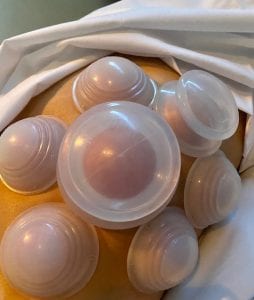
Is Cupping for Me?
Have you experienced tight muscles, pain, limited mobility or range of motion, tendinitis, or pinched nerves? Are you someone who feels “on” all the time and muscles are tense, even after a massage, and/or you feel like everything is stuck together? If any of these are a yes, then you may be a candidate for cupping. We promise it’s not as scary as it looks.
What is cupping? Cupping is the opposite of massage or pressure. It uses “negative pressure” or suction to pull rather than push. So imagine a couple analogies: the muscle tissue is like a hard/cold stick of butter and after cupping, it feels like a soft, room-temperature stick of butter. Or what about matted down carpet. You know the kind… you can see the path and everything. By utilizing two specific methods of cupping, it helps to restore the carpet (AKA muscle) to how it’s meant to be naturally. Our musculoskeletal system is made up of not only muscles, nerves, bone and circulatory system, but also a key player called fascia, or connective tissue. Fascia is the glue that binds all of our musculoskeletal system together. Fascia is everywhere…eyes, viscera, skin, ligaments, tendons, etc. You could strip away everything but fascia and we could identify everyone just by their fascia, it’s so prevalent and specific. Fascia also creates scar tissue and can impinge on nerves. This is why cupping is so great, it helps “reorganize/remodel” fascia and send immediate, fresh blood flow to the area to speed healing. When trigger points (painful muscle knots that often cause referred pain or sensation) are present, they can cause ischemia, or lack of blood flow. Releasing them in combination with cupping extends the “benefit period” of massage than just hands-on alone.
There are several cupping methods but we use two main types: dynamic cupping (which is also called gliding or massage cupping) and that is often done to warm up the area for a few minutes. This is key to creating more space for muscle and fascia to settle, and accelerating the warm-up process. Most people do not get marking from dynamic cupping. We can always just do this if you are concerned with marks.
Static cupping is placing cups in the problem area for any length of time, usually 2-15 minutes. We use clear silicone or polycarbonate vacuum cups so we can always monitor the changes inside the cup. Marking is a normal reaction and it usually doesn’t hurt. Occasionally the area may be sore for a day. This is also normal. It’s normal not to mark as well. Many guests have cupping each week, sometimes they mark, sometimes they don’t. Technically, marks are bruises but they look and heal more like a round suction mark.Static cupping is effective especially for limited range of motion, and with that we do blanket static cupping with mobilization. Basically several cups close together and moving the area/extremity around for greater impact.
What are the side effects? For many people, they feel a little more “massage drunk” and for others they may feel extra tired. Other normal side effects are: headache, dizziness, nausea/vomiting, localized swelling, fatigue. Most of these subside within a few hours to a day. It’s important to drink plenty of water, treat your body well, and eat clean. If side effects are bothersome, see if the benefits of treatment outweigh the side effects. Again, many people are just tired, but these are completely normal.
How often can I have cupping?:
You can have it done every week! Julie offers cupping sessions by appointment only on Tuesdays and Thursdays, 25 min, $45. These sessions are for treating one problem or area. If the area is more than can be treated in 25 minutes, she will recommend booking longer time in the future. You can also do cupping as your enhancement in your booked massages.
What is the cupping flow in the session?
This can change, but usually we will warm up the area, then begin with a few minutes of dynamic cupping, following by hands on work, finished with static cupping and mobilization if applicable. Depending on length of treatment, other areas may be worked while static cups are in place.
Who should not have cupping? (some of these are localized contraindications)
- Varicose veins (no massage at all on area, only above)
- New tattoos less than 6 weeks old
- Fillers / testosterone pellets
- Cancer
- Organ failure
- Pacemakers, e-stim devices, pain pumps, insulin pumps
- Blood disorders (clotting, anemia, hemophilia, etc)
- Taking any blood thinners including baby aspirin
- Acute infections
- Severe chronic disease (heart, liver, lung, etc)
- Recent blood donor or undergone medical procedures (be completely recovered)
- Pregnancy (it depends)
Again what are the benefits?
-
- Provides “negative pressure” or suction to pull rather than push and create more space for fascia, muscle, and movement
- Increases circulation
- Reduces pain
- Can increase ROM when limited ROM
- Entrapment syndromes/pinched nerves
- Arthritis/tendinitis, many other kinds of “itis”
- Muscular tightness, tension, “stuck tissue,” stress
- Remodeling, restructuring, repairing, restoring, reposturing
Leave a Reply
You must be logged in to post a comment.